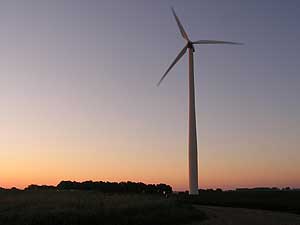|
Audio
Photos
|
July 5, 2005
 |
| A wind turbine at the Chandler Hills Wind Farm in southwest Minnesota. Electricity from this machine goes to wind customers across the state. (MPR Photo/Mark Steil) |
Chandler, Minn. — The wind power option arrived in Minnesota nearly 10 years ago, when Dakota Electric Association surveyed its customers. The company serves the southern part of the Twin Cities. Dakota Electric public relations specialist Joe Miller says the survey showed the company had some motivated customers.
"There was an interest in wind power, or green power resources, and that people would pay a little extra," says Miller.
Miller says the company took the survey to Great River Energy based in Elk River, the utility which provides power for Dakota Electric and more than than two dozen other coops. The company agreed to build some wind turbines on Buffalo Ridge in southwest Minnesota. The Great River turbines are located on a bluff overlooking the town of Chandler. The company built its first turbines here seven years ago.
Greg Raschke works for the company which services the machines. As he watches the long blades slice the air, he says wind conditions here are just right.
"Today's perfect, they're making money today," says Raschke.
There are nine wind machines in all, each as tall as a 20 story building. Raschke says one turbine generates enough electricity for 200 homes.
"They're run 24 hours a day, seven days a week. They only time they're not running is when the wind's not blowing," says Raschke.
The electricity flows from the Chandler site into the power grid, where it merges with electricity from all sorts of sources: coal fired plants, natural gas peaking facilities, hydro-power, nuclear.
The customers who buy wind power are told it's impossible to tell how the electricity reaching their home was produced. Mary Surma of Little Falls understands that. She pays about $10 a month extra for wind energy. Customers like her can buy wind in blocks. She buys enough to match her household use. Others buy some percentage of their home's demand. Surma says buying green power insures that more wind farms are built, reducing the need for less friendly sources of electricity.
"I read up on coal plants and how much harm they're doing to the air," says Surma. "I know that 88 percent of our energy comes from coal plants, and they have a lot of toxins that they emit and wind power has none of that. So it just seemed like the smart thing to do. I felt like I had a duty to do that."
Supporters of coal fired plants point out that they have taken significant steps to reduce emissions. Still, Surma's sense of duty seems to characterize many customers of the green economy. Alfred Marcus teaches at the University of Minnesota's Carlson School of Management. He says selling wind power taps strong convictions in a select group.
"There are some people that are going to do this as a matter of pure, altruistic charity. Because they believe it's the absolute right to do and even if it costs them something they're going to come forward and do it," says Marcus.
He says that's a relatively small group, maybe five percent of the population. He says beyond that core it becomes more difficult to motivate people to buy wind power, especially when it costs extra. He says the big problem is that buying green power is nearly invisible. Unlike the buyer of a hybrid car, the consumer has nothing to show off.
"A good campaign for green power would require some way of having people show, display, publicly that they have actually purchased green power," says Marcus. "One of the most successful programs of that nature that I know about is in Switzerland where people who purchase green power actually put a sticker on their door."
Nothing like that has been tried in Minnesota, but still thousands have signed up. Supporters say it demonstrates that people will spend more for sound environmental tools given the chance.




